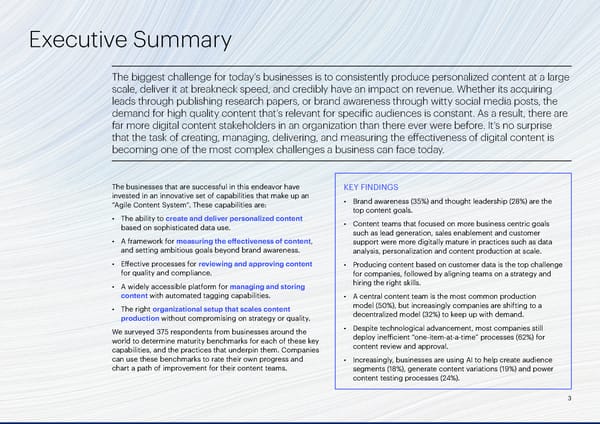Executive Summary The biggest challenge for today’s businesses is to consistently produce personalized content at a large scale, deliver it at breakneck speed, and credibly have an impact on revenue. Whether its acquiring leads through publishing research papers, or brand awareness through witty social media posts, the demand for high quality content that’s relevant for specific audiences is constant. As a result, there are far more digital content stakeholders in an organization than there ever were before. It’s no surprise that the task of creating, managing, delivering, and measuring the effectiveness of digital content is becoming one of the most complex challenges a business can face today. The businesses that are successful in this endeavor have KEY FINDINGS invested in an innovative set of capabilities that make up an • Brand awareness (35%) and thought leadership (28%) are the “Agile Content System”. These capabilities are: top content goals. • The ability to create and deliver personalized content • Content teams that focused on more business centric goals based on sophisticated data use. such as lead generation, sales enablement and customer • A framework for measuring the effectiveness of content, support were more digitally mature in practices such as data and setting ambitious goals beyond brand awareness. analysis, personalization and content production at scale. • Effective processes for reviewing and approving content • Producing content based on customer data is the top challenge for quality and compliance. for companies, followed by aligning teams on a strategy and • A widely accessible platform for managing and storing hiring the right skills. content with automated tagging capabilities. • A central content team is the most common production • The right organizational setup that scales content model (50%), but increasingly companies are shifting to a production without compromising on strategy or quality. decentralized model (32%) to keep up with demand. We surveyed 375 respondents from businesses around the • Despite technological advancement, most companies still world to determine maturity benchmarks for each of these key deploy inefficient “one-item-at-a-time” processes (62%) for capabilities, and the practices that underpin them. Companies content review and approval. can use these benchmarks to rate their own progress and • Increasingly, businesses are using AI to help create audience chart a path of improvement for their content teams. segments (18%), generate content variations (19%) and power content testing processes (24%). 3
 State of Digital Content Page 2 Page 4
State of Digital Content Page 2 Page 4